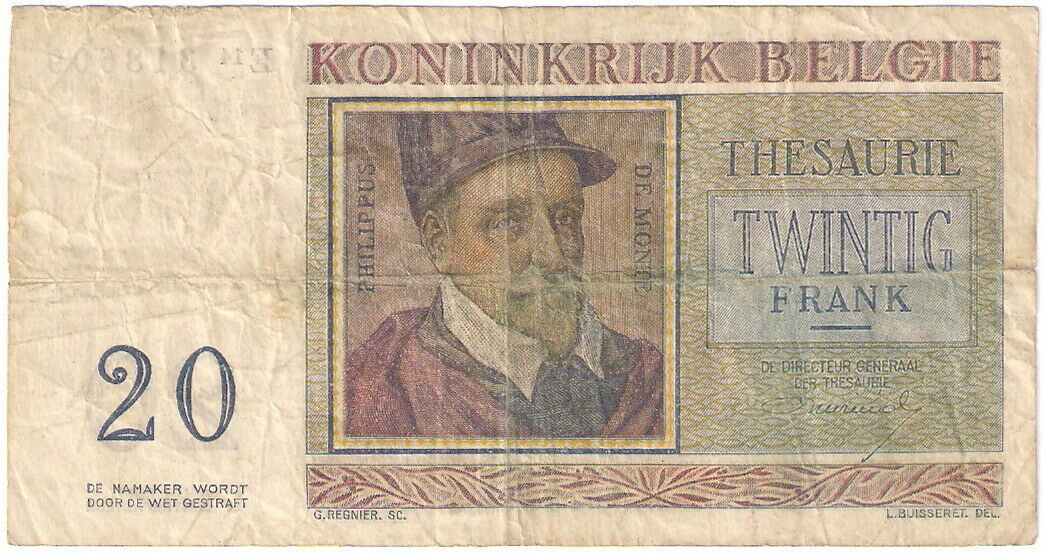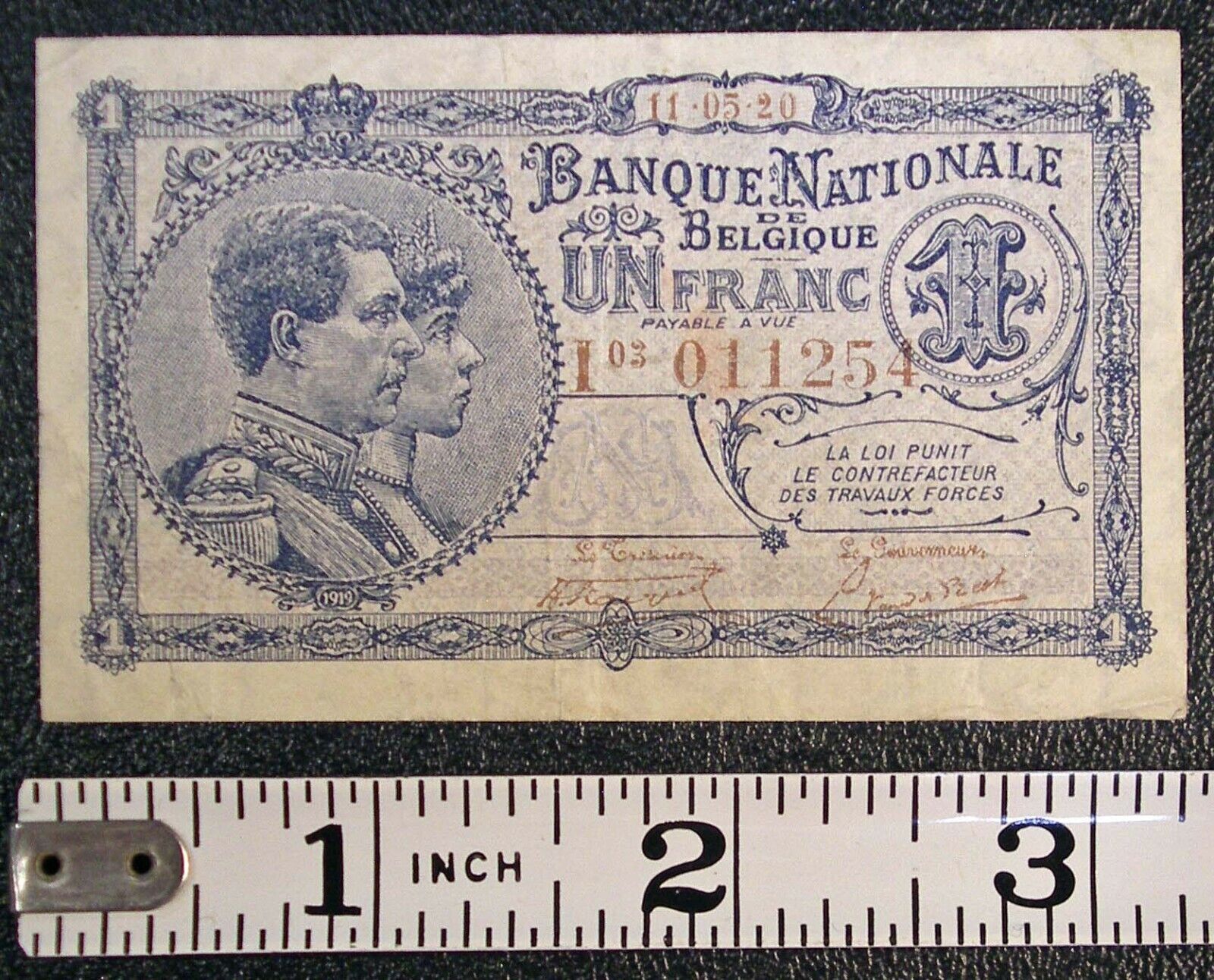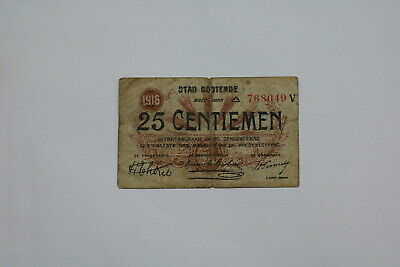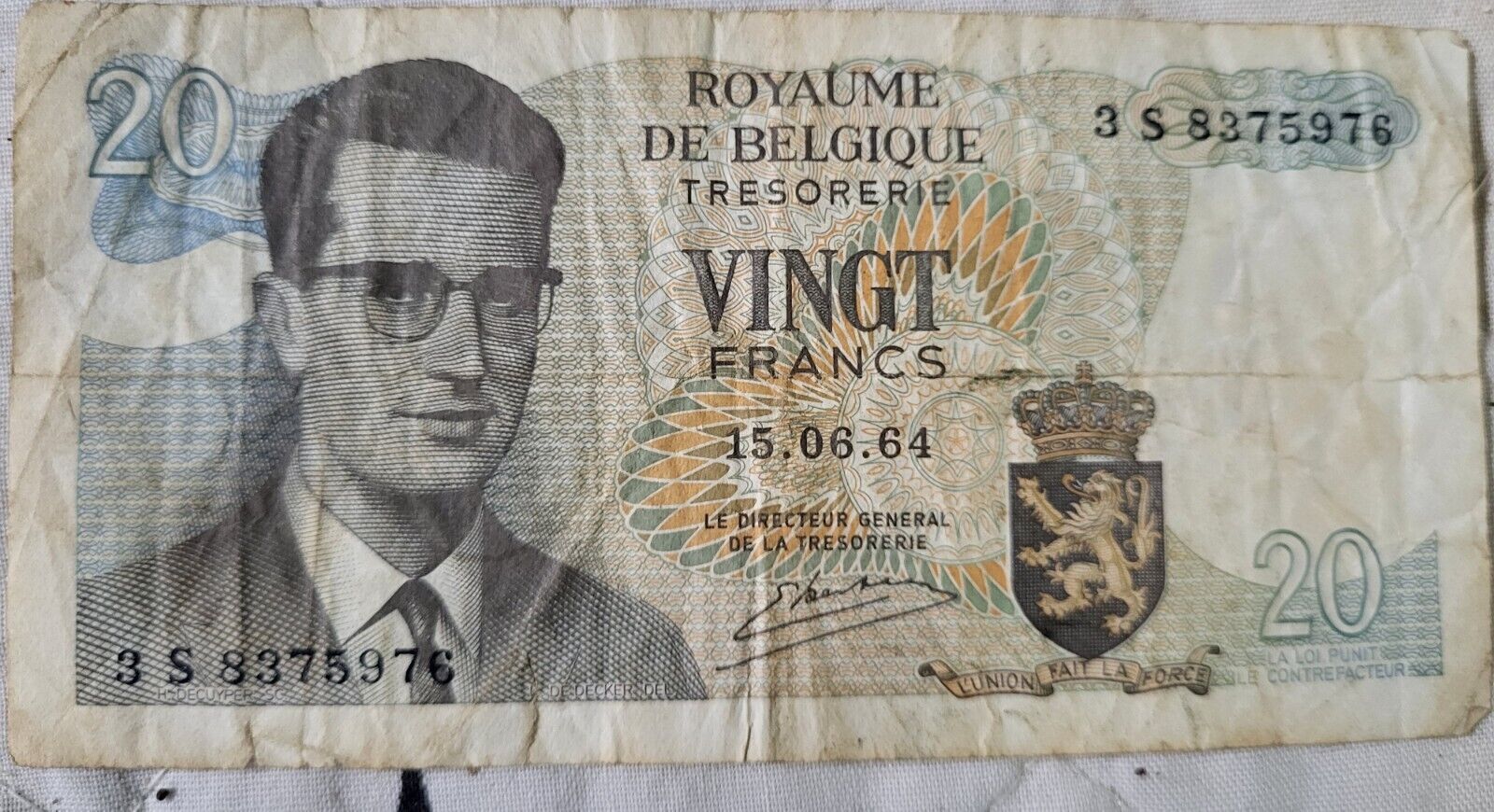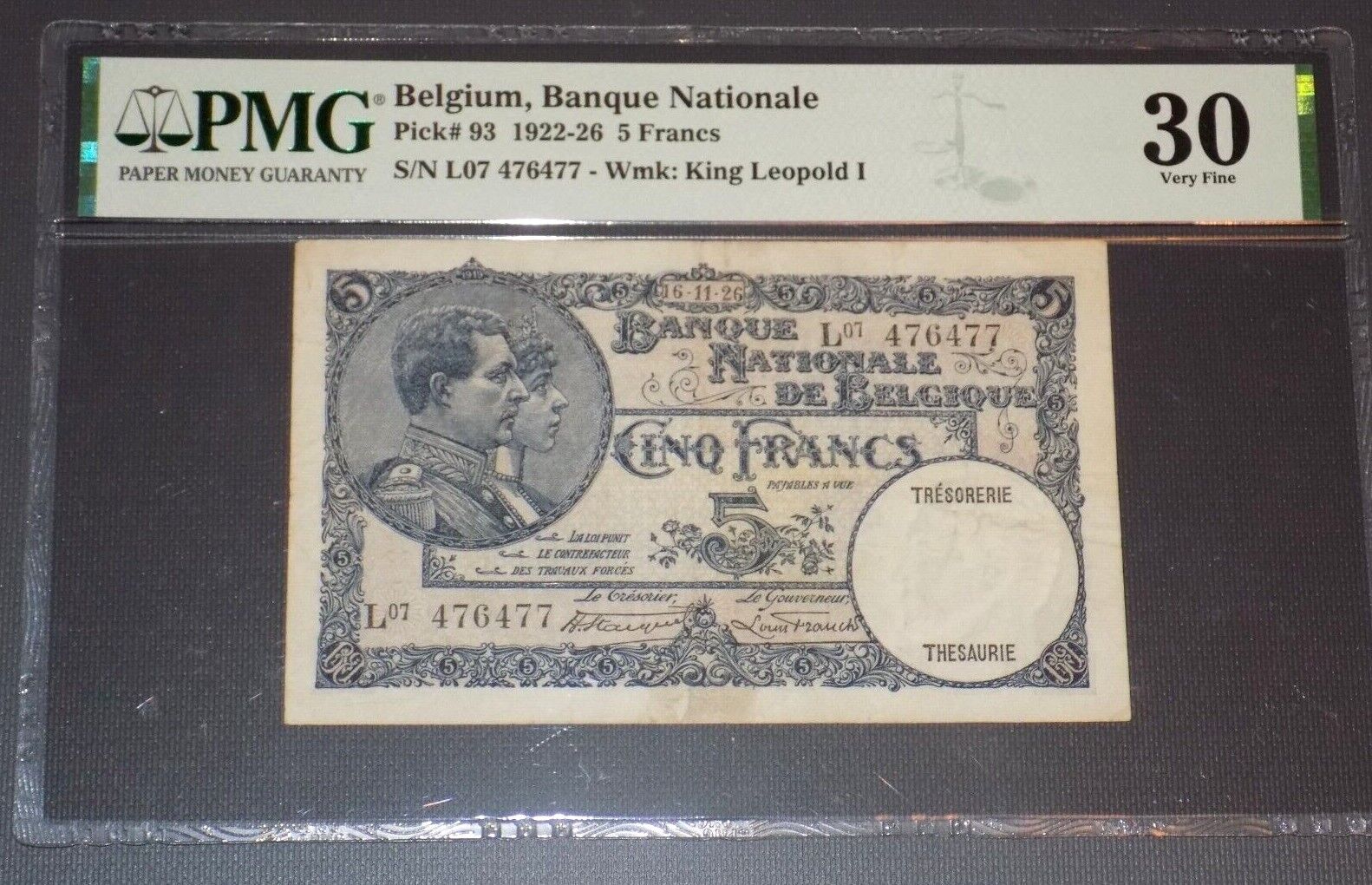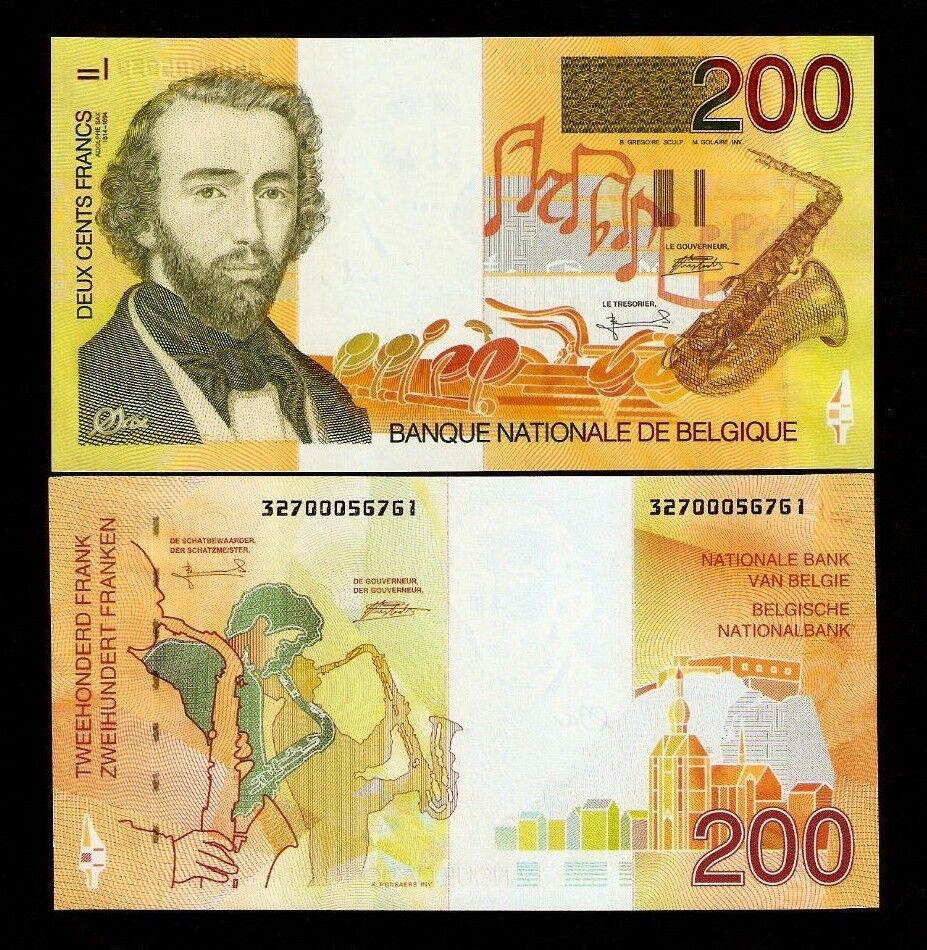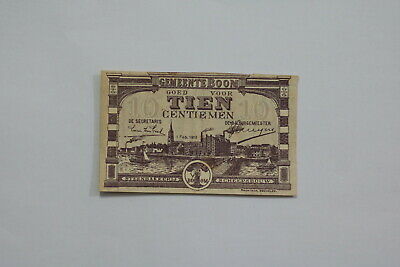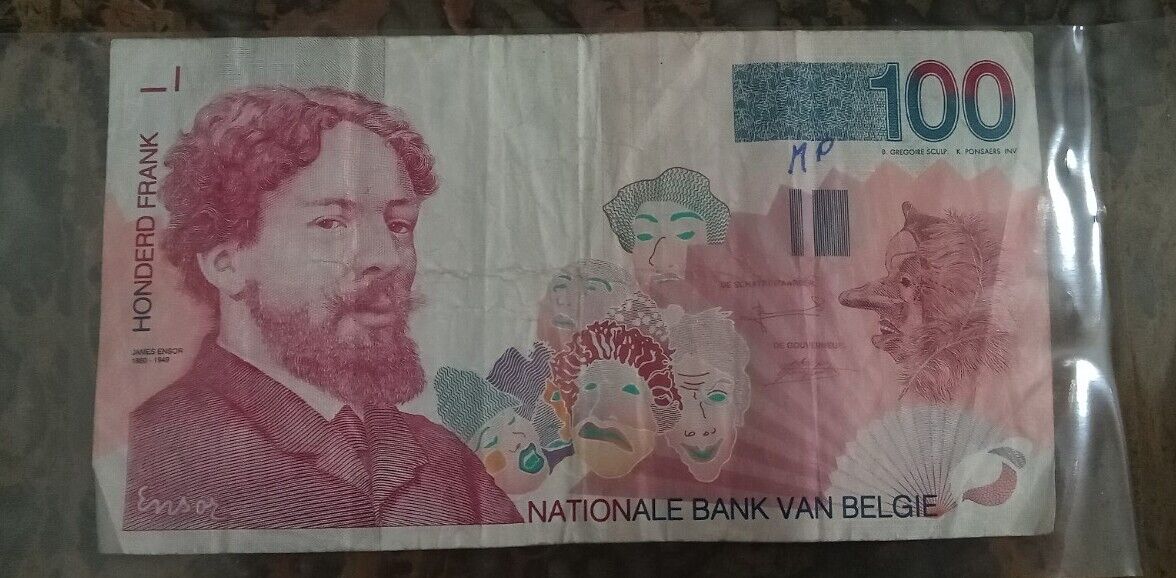-40%
Belgium banknote - 20 vingt francs - year 1956 - P. de Monte & Orlando di Lassus
$ 6.33
- Description
- Size Guide
Description
The Belgian franc (French: Franc belge, Dutch: Belgische frank, German: Belgischer Franken) was the currency of the Kingdom of Belgium from 1832 until 2002 when the Euro was introduced. It was subdivided into 100 subunits, known as centimes (French), centiem (Dutch) or Centime (German).The conquest of most of western Europe by revolutionary and Napoleonic France led to the French franc's wide circulation. In the Austrian Netherlands (the current Belgium), the franc replaced the kronenthaler. This was in turn replaced by the Dutch guilder when the United Kingdom of the Netherlands was formed.
Following independence from the Kingdom of the Netherlands, the new Kingdom of Belgium in 1832 adopted its own franc, equivalent to the French franc, followed by Luxembourg in 1848 and Switzerland in 1850.
Belgian mint working during the late 19th century was innovative and Belgium was the first country to introduce coins made of cupronickel, in 1860.
In 1865, Belgium, France, Switzerland and Italy created the Latin Monetary Union (to be joined by Greece in 1868): each would possess a national currency unit (franc, lira, drachma) worth 4.5 g of silver or 290.322 mg of fine gold, all freely exchangeable at a rate of 1:1. In the 1870s the gold value was made the fixed standard, a situation which was to continue until 1914.
In 1926, Belgium, as well as France, experienced depreciation and an abrupt collapse of confidence, leading to the introduction of a new gold currency for international transactions, the Belga worth 5 francs, and the country's withdrawal from the monetary union, which ceased to exist at the end of the year. The Belga was tied to the British pound at a rate of 35 belgas (175 francs) = 1 pound and was thus put on a gold standard of 1 Belga = 209.211 mg fine gold. The 1921 monetary union of Belgium and Luxembourg survived, however, forming the basis for full economic union in 1932. In 1935, the Belgian franc was devalued by 28% to 150.632 mg fine gold and the link between the Luxembourg and Belgian francs was revised to 1 Luxembourgish franc = 1 1?4 Belgian francs.
Following Belgium's occupation by Germany in May 1940, the franc was fixed at a value of 0.1 Reichsmark, reduced to 0.08 Reichsmark in July 1940. Following liberation in 1944, the franc entered into the Bretton Woods system, with an initial exchange rate of 43.77 francs = US dollar set on October 5. This was changed to 43.8275 in 1946 and then to 50 following the devaluation of the British pound in September 1949. The Belgian franc was devaluated again in 1982.
Like 10 other European currencies, the Belgian/Luxembourgish franc ceased to exist on January 1, 1999, when it became fixed at 1 EUR= 40.3399 BEF/LUF, thus a franc was worth € 0.024789. Old franc coins and notes lost their legal tender status on February 28, 2002.
Signature Williot 3.4.1956.
Portrait R. de Lassus at center.
Portrait P. de Monte at center.
Lilac, violet and blue.
Philippe de Monte
Philippe de Monte, also known as Philippus de Monte and Filippo di Monte (born 1521, Mechelen, Flanders [now in Belgium]—died July 4, 1603, Prague, Bohemia [now in Czech Republic]), one of the most active composers of the Netherlandish, or Flemish, school that dominated Renaissance music; he is especially known for his sacred music and for his madrigals. Like many Netherlandish composers at the time, Monte journeyed to Italy to pursue his career. He spent his early adulthood as a music instructor in the employ of a wealthy family in Naples. By 1554, the year his first book of madrigals saw publication, he had returned to the Low Countries. Monte then visited England in 1554–55 as a singer in the chapel of Philip II of Spain (the consort of Queen Mary I), and while there he befriended the adolescent William Byrd. He eventually moved back to Italy, where he lived in peripatetic fashion as a teacher and composer. Monte was in Rome in 1568 when he became musical director to the Habsburg emperor Maximilian II at his court in Vienna. He flourished in the following years, publishing his work regularly and actively participating in prestigious royal celebrations. When Maximilian died and his son Rudolf II acceded to the throne in 1576, Monte remained in his position. Four years later he transferred to Prague, which Rudolf had made the new imperial residence. Although Monte was apparently unhappy in Rudolf’s court, in which music played a less central role than it had in Maximilian’s, he was highly productive. In addition, while serving the emperors, he was awarded honorary posts at Cambrai Cathedral in what is now France. Monte’s hundreds of compositions are characterized by a fluent but nonexperimental technique, and he excelled in subtle contrasts of register and voice grouping. Of the variety of voicings that appear in his repertoire, he most commonly composed for five parts. Monte’s sacred works, which stand comparison with those of Italian composer Giovanni Pierluigi da Palestrina, include approximately 40 masses, most of which are parodies, and at least 250 motets that are noted for their elegance. Although Monte wrote several dozen chansons, the overwhelming majority of his secular compositions are madrigals. Indeed, not only was he one of the last Netherlandish masters of the form, but he was the most prolific of his contemporaries, publishing more than 1,200 (including some spiritual madrigals) in nearly 40 books during his lifetime. Although Monte’s madrigals are typified by their solemnity, he gradually developed an individualistic style in which balance was provided by energetic rhythms. Many of his early works in the form are settings of Petrarch.
Orlando di Lasso
Orlando di Lasso, Latin Orlandus Lassus, also called Roland De Lassus (born 1530/32, Mons, Spanish Hainaut—died June 14, 1594, Munich), Flemish composer whose music stands at the apex of the Franco-Netherlandish style that dominated European music of the Renaissance. As a child he was a choirboy at St. Nicholas in Mons and because of his beautiful voice was kidnapped three times for other choirs. He was taken into the service of Ferdinand of Gonzaga, general to Charles V, and travelled with the imperial army in its French campaign in 1544. He accompanied Gonzaga to Italy in 1544, where he remained for 10 years. From 1553 to 1554 he was chapelmaster of the papal church of St. John Lateran at Rome, a post later held by Palestrina. Following a sojourn in Antwerp (1555–56), he joined the court chapel of Duke Albrecht V of Bavaria in Munich, where, except for some incidental journeys, he remained for the rest of his life. In 1570 the Emperor Maximilian raised him to the nobility; and, when Lasso dedicated a collection of his masses (1574) to Pope Gregory XIII, he received the knighthood of the Golden Spur. Of Lasso’s more than 2,000 compositions, many appeared in print between 1555, when his first book of Italian madrigals was published in Venice, and 1604, when a posthumous collection of 516 Latin motets (religious choral works), Magnum Opus Musicum, was published by his sons. Certain volumes stand out as landmarks in his career: his first collection of motets (1556) established his mastery in a field to which he contributed all his life; a comprehensive anthology of his chansons, or French part-songs (1570), helped to consolidate his position as the leading composer in this genre. In addition to his madrigals (Italian choral pieces) and chansons, he published seven collections of lieder (German part-songs). Probably his best known work is his sombre, impressive collection of penitential psalms, Psalmi Davidis Poenitentiales (1584). Its rediscovery and edition in 1838 by S.W. Dehn initiated a revival of interest in Lasso’s works. Lasso was a master in the field of sacred music and was equally at home in secular composition. In the latter field his internationalism is striking, encompassing Italian, French, and German genres. His religious works have a particular emotional intensity. He took great care to mirror the meaning of his texts in his music, a trait that looked forward to the Baroque style of the early 17th century.
